1 认识ElasticSearch
(一)基于数据库查询的问题

需求: 查询title中包含‘手机’ 的信息?
实现:SELECT * FROM tb_item WHERE title LIKE ‘%手机%’;
问题:
(1)性能低:如果是模糊查询,坐标有通配符,不会走索引,会进行全表扫描,性能低。
(2)功能弱:如果以”华为手机“作为条件,查询不出来数据。
解决:使用ES就可以倒排索引就可以解决上述存在的问题
(二)倒排索引
1 倒排索引概念
倒排索引:将文档进行分词,形成词条和id的对应关系即为反向索引。
2 倒排索引案例
以唐诗为例,所处包含“前”的诗句?
正向索引:由《静夜思》–>床前明月光—>“前”字
| key | value |
|---|---|
| «静夜思» | 窗前明月光,疑是地上霜… |
| «水调歌头» | 明月几时有,把酒问青天… |
| «春晓» | 春眠不觉晓,处处闻啼鸟… |
反向索引:
“床前明月光”–> 分词
将一段文本按照一定的规则,拆分为不同的词条(term)
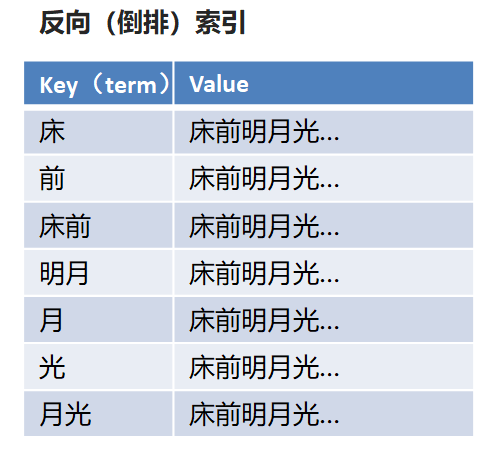
案例:明月几时有,分词。分词效果如下
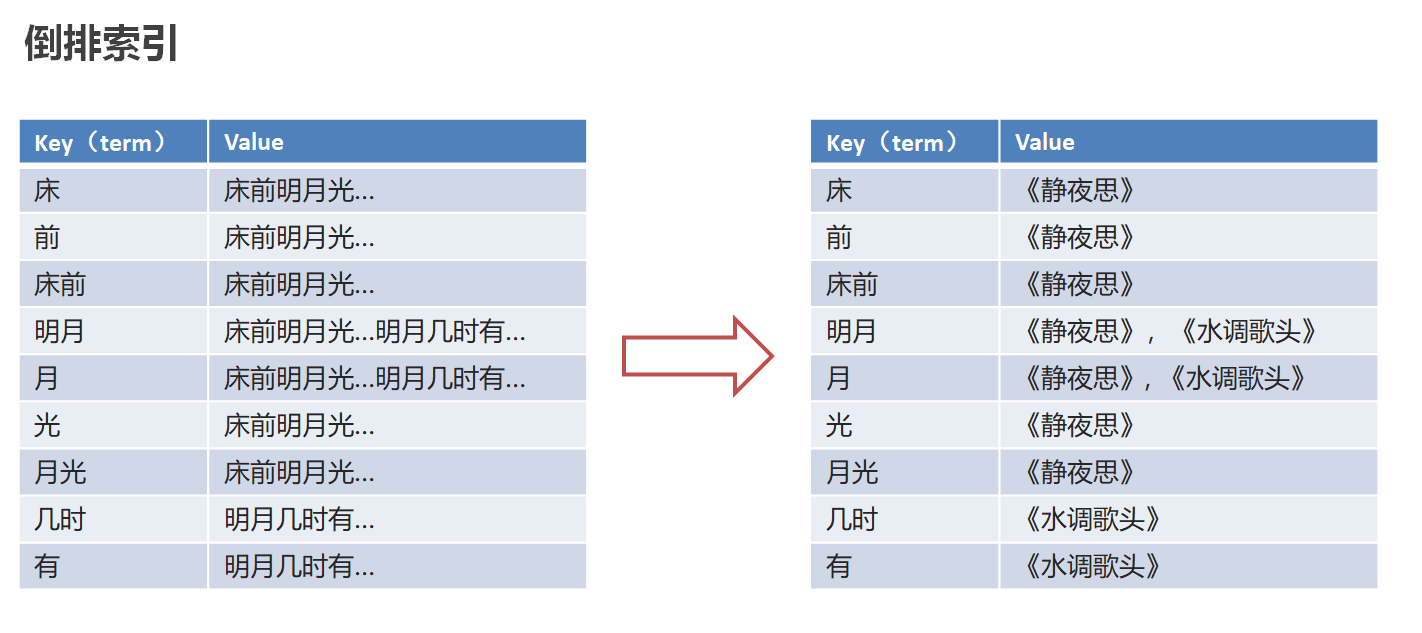
(三)ElasticSearch存储和查询的原理
index(索引):相当于mysql的库
映射:相当于mysql 的表结构
document(文档):相当于mysql的表中的数据
Es使用倒排索引,对title 进行分词
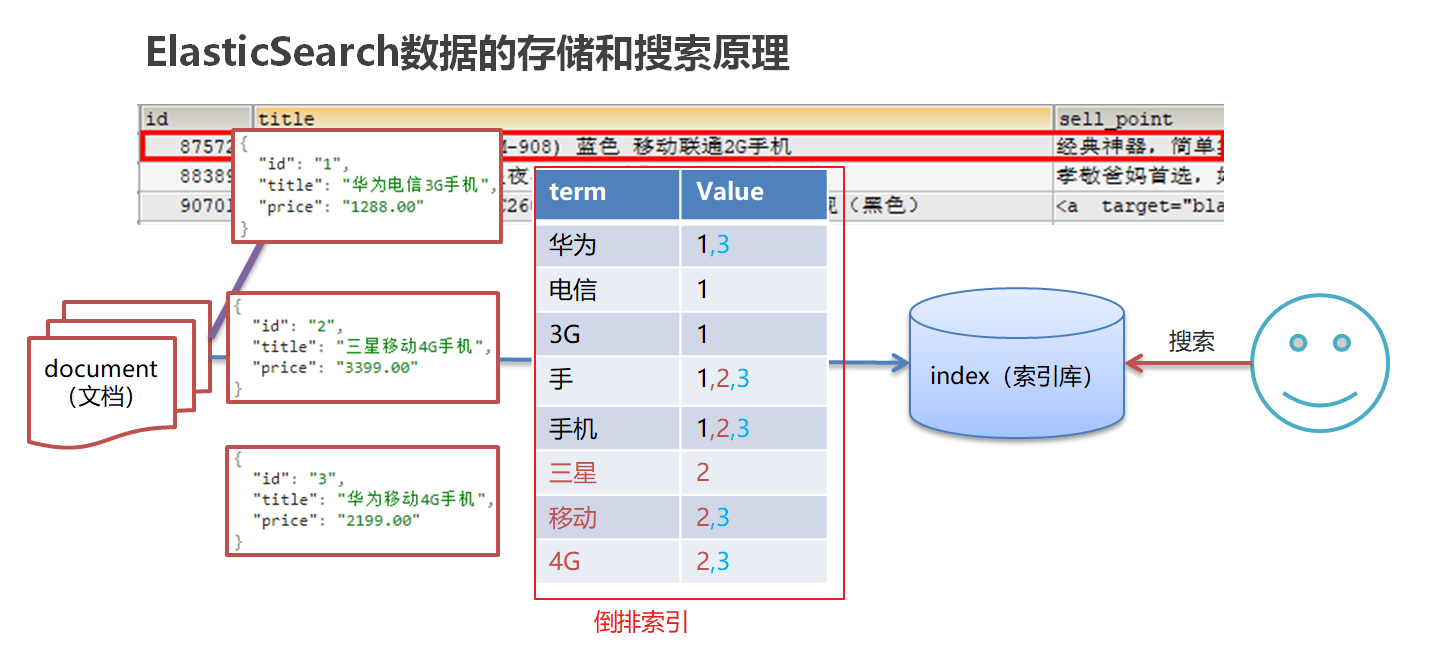
-
使用“手机”作为关键字查询
生成的倒排索引中,词条会排序,形成一颗树形结构,提升词条的查询速度
-
使用“华为手机”作为关键字查询
华为:1,3
手机:1,2,3
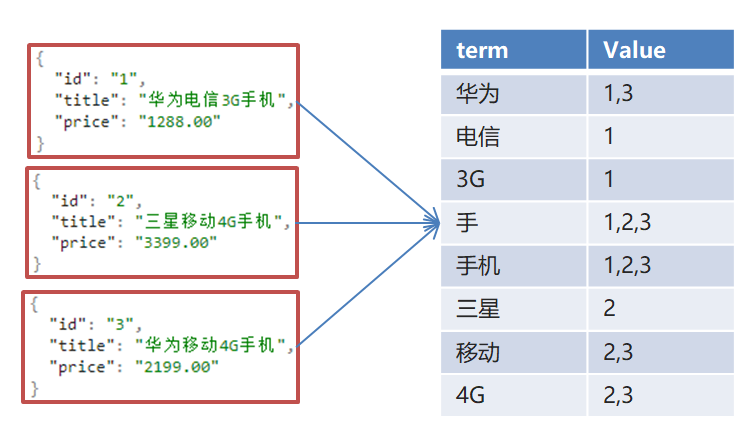
(四)ElasticSearch概念详解
ElasticSearch是一个基于Lucene的搜索服务器
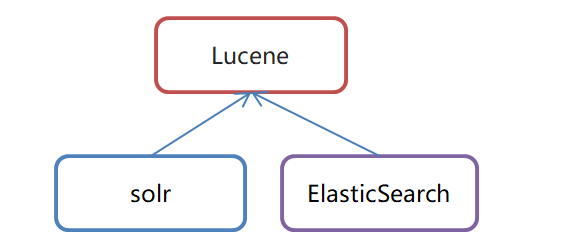
是一个分布式、高扩展、高实时的搜索与数据分析引擎
基于RESTful web接口
Elasticsearch是用Java语言开发的,并作为Apache许可条款下的开放源码发布,是一种流行的企业级搜索引擎
官网:https://www.elastic.co/
应用场景
搜索:海量数据的查询
日志数据分析
实时数据分析
2 安装ElasticSearch
(一)ElasticSearch安装
1 上传ElasticSearch安装包

2 执行解压操作
#创建一个安装目录
mkdir /usr/local/es
#将elasticsearch-7.4.0-linux-x86_64.tar.gz解压到/usr/local/es 目录下. -C 大写
tar -zxvf elasticsearch-7.4.0-linux-x86_64.tar.gz -C /usr/local/es
3 创建普通用户
因为安全问题,Elasticsearch 不允许root用户直接运行,所以要创建新用户,在root用户中创建新用户,执行如下命令:
useradd offcn #新增offcn账户
passwd offcn #为offcn账户设置密码
4 为新用户授权,如下图
chown -R offcn:offcn /usr/local/es/elasticsearch-7.4.0 #文件夹所有者

将 /usr/local/es/elasticsearch-7.4.0文件夹授权给offcn用户,由上图可见,我们的文件夹权限赋给了offcn
5 修改elasticsearch.yml文件
vim /usr/local/es/elasticsearch-7.4.0/config/elasticsearch.yml
# ======================== Elasticsearch Configuration =========================
cluster.name: my-application
node.name: node-1
network.host: 0.0.0.0
http.port: 9200
cluster.initial_master_nodes: ["node-1"]
cluster.name:配置elasticsearch的集群名称,默认是elasticsearch。建议修改成一个有意义的名称
node.name:节点名,elasticsearch会默认随机指定一个名字,建议指定一个有意义的名称,方便管理
network.host:设置为0.0.0.0允许外网访问
http.port:Elasticsearch的http访问端口
cluster.initial_master_nodes:初始化新的集群时需要此配置来选举master
6 修改虚拟机的配置文件
新创建的offcn用户最大可创建文件数太小,最大虚拟内存太小,切换到root用户,编辑下列配置文件, 添加类似如下内容
# 切换到root用户
su root
#1. ===最大可创建文件数太小=======
vim /etc/security/limits.conf
# 在文件末尾中增加下面内容
offcn soft nofile 65536
offcn hard nofile 65536
#===========
vim /etc/security/limits.d/20-nproc.conf
# 在文件末尾中增加下面内容
offcn soft nofile 65536
offcn hard nofile 65536
* hard nproc 4096
# 注:* 代表Linux所有用户名称
#2. ===最大虚拟内存太小=======
vim /etc/sysctl.conf
# 在文件中增加下面内容
vm.max_map_count=655360
# 重新加载,输入下面命令:
sysctl -p
7 启动ElasticSearch
su offcn #切换到offcn 用户启动
cd /usr/local/es/elasticsearch-7.4.0/bin
./elasticsearch #启动
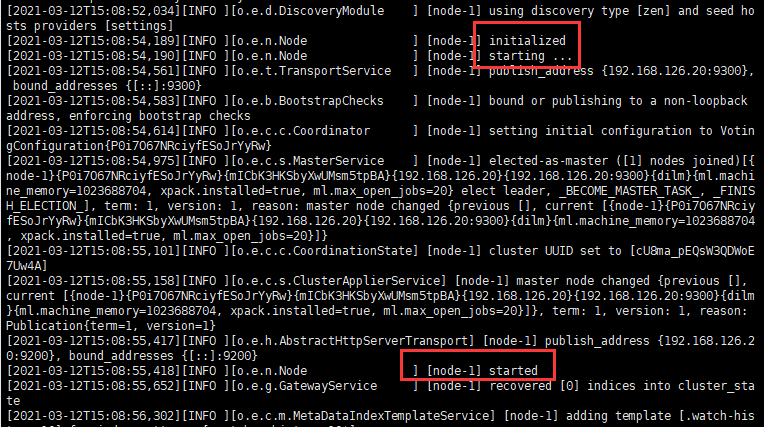
通过上图我们可以看到elasticsearch已经成功启动
8 查看ElasticSearch是否启动
ps -ef|grep elastic
(二)访问ElasticSearch
1 关闭防火墙
#暂时关闭防火墙
systemctl stop firewalld.service
# 或者
#永久设置防火墙状态
systemctl enable firewalld.service #打开防火墙永久性生效,重启后不会复原
systemctl disable firewalld.service #关闭防火墙,永久性生效,重启后不会复原
2 浏览器访问
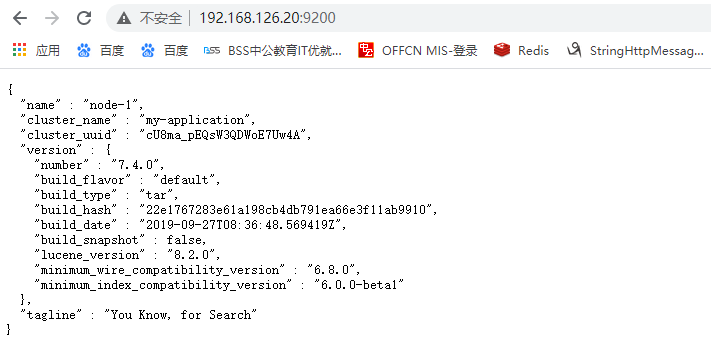
说明: 此时elasticsearch已成功启动
重点几个关注下即可:
number" : "7.4.0" 表示elasticsearch版本
lucene_version" : "8.2.0" 表示lucene版本
name : 默认启动的时候指定了 ES 实例名称
cluster_name : 默认名为 elasticsearch
3 ElasticSearch辅助工具安装
(一) Postman 介绍和安装
Postman是一个http模拟请求的工具。
官网介绍:“Modern software is built on APIs,Postman helps you develop APIs faster”
看得出来,它是一个专门测试 API 的工具,Postman 提供功能强大的 Web API 和 HTTP 请求的调试,它能够发送任何类型的HTTP 请求 (GET, POST, PUT, DELETE…),并且能附带任何数量的参数和 Headers。不仅如此,它还提供测试数据和环境配置数据的导入导出。
进入官网www.getpostman.com,下载
(二) Kibana介绍&安装
1 什么是Kibana
Kibana是一个针对Elasticsearch的开源分析及可视化平台,用来搜索、查看交互存储在Elasticsearch索引中的数据。使用Kibana,可以通过各种图表进行高级数据分析及展示。
Kibana让海量数据更容易理解。它操作简单,基于浏览器的用户界面可以快速创建仪表板(dashboard)实时显示Elasticsearch查询动态。
2 Kibana安装
2.1 上传kibana

2.2 解压kibana到安装目录
#创建安装目录
mkdir /usr/local/kibana
#将kibana解压到安装目录
tar -zxvf kibana-7.4.0-linux-x86_64.tar.gz -C /usr/local/kibana
2.3 修改kibana配置
vim /usr/local/kibana/kibana-7.4.0-linux-x86_64/config/kibana.yml
server.port: 5601
server.host: "0.0.0.0"
server.name: "kibana-offcn"
elasticsearch.hosts: ["http://127.0.0.1:9200"]
elasticsearch.requestTimeout: 99999
server.port:http访问端口
server.host:ip地址,0.0.0.0表示可远程访问
server.name:kibana服务名
elasticsearch.hosts:elasticsearch地址
elasticsearch.requestTimeout:请求elasticsearch超时时间,默认为30000,此处可根据情况设置
2.4 启动kibana
由于kibana不建议使用root用户启动,如果用root启动,需要加–allow-root参数
# 切换到kibana的bin目录
cd /usr/local/kibana/kibana-7.4.0-linux-x86_64/bin
# 启动
./kibana --allow-root
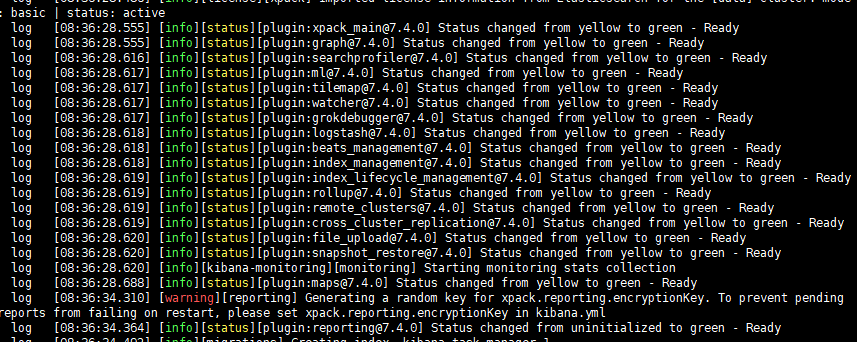
启动成功。
2.5 访问kibane
访问地址: http://192.168.126.20:5601/
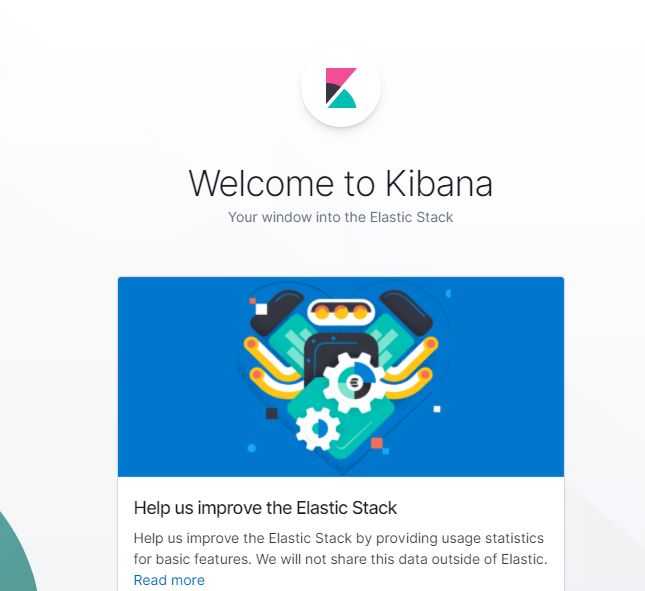
(三)IK分词器安装
1 环境准备
Elasticsearch 要使用 ik,就要先构建 ik 的 jar包,这里要用到 maven 包管理工具,而 maven 需要java 环境,而 Elasticsearch 内置了jdk, 所以可以将JAVA_HOME设置为Elasticsearch 内置的jdk
1.1 设置JAVA_HOME
vim /etc/profile
# 在profile文件末尾添加
#java environment
export JAVA_HOME=/usr/local/es/elasticsearch-7.4.0/jdk
export PATH=$PATH:${JAVA_HOME}/bin
# 保存退出后,重新加载profile
source /etc/profile
1.2 下载maven安装包
#安装包较小,直接使用wget命令下载,下载的默认位置,当前所在的位置
wget http://mirror.cc.columbia.edu/pub/software/apache/maven/maven-3/3.1.1/binaries/apache-maven-3.1.1-bin.tar.gz
1.3 解压maven安装包
#创建maven的安装包
mkdir /usr/local/maven/
#解压到指定的目录
tar -zxvf apache-maven-3.1.1-bin.tar.gz -C /usr/local/maven/
1.4 设置软连接
ln -s apache-maven-3.1.1 maven
1.5 设置path
#打开文件
vim /etc/profile.d/maven.sh
#将下面的内容复制到文件,保存
export MAVEN_HOME=/usr/local/maven/maven
export PATH=${MAVEN_HOME}/bin:${PATH}
#设置好Maven的路径之后,需要运行下面的命令使其生效
source /etc/profile.d/maven.sh
1.6 验证maven是否安装成功
mvn -v
1.7 设置maven的阿里云镜像
<mirror>
<id>alimaven</id>
<name>aliyun maven</name>
<url>http://maven.aliyun.com/nexus/content/groups/public/</url>
<mirrorOf>central</mirrorOf>
</mirror>
2 安装IK分词器
2.1 下载IK分词器
wget https://github.com/medcl/elasticsearch-analysis-ik/archive/v7.4.0.zip
2.2 解压IK到指定目录
由于这里是zip包不是gz包,所以我们需要使用unzip命令进行解压,如果本机环境没有安装unzip,请执行:
yum install zip
yum install unzip
解压IK
unzip v7.4.0.zip
2.3 编译jar包
# 切换到 elasticsearch-analysis-ik-7.4.0目录
cd elasticsearch-analysis-ik-7.4.0/
#打包,注意第一次使用maven会比较慢,提前配置好阿里云镜像
mvn package
2.4 jar包移动
#切换目录
cd /usr/local/es/elasticsearch-7.4.0/plugins/
#新建目录
mkdir analysis-ik
cd analysis-ik
#执行拷贝
cp -R /opt/elasticsearch-analysis-ik-7.4.0/target/releases/elasticsearch-analysis-ik-7.4.0.zip /usr/local/es/elasticsearch-7.4.0/plugins/analysis-ik
#执行解压
unzip /usr/local/es/elasticsearch-7.4.0/plugins/analysis-ik/elasticsearch-analysis-ik-7.4.0.zip
2.5 拷贝词典
将elasticsearch-analysis-ik-7.4.0目录下的config目录中的所有文件 拷贝到elasticsearch的config目录
cp -R /opt/elasticsearch-analysis-ik-7.4.0/config/* /usr/local/es/elasticsearch-7.4.0/config
2.6 重新启动
配置成功之后,重新启动ES,重新启动Kibana,使用IK分词器。
(四)使用IK分词器
1 IK分词器使用
IK分词器有两种分词模式:ik_max_word和ik_smart模式。
1.1ik_max_word
会将文本做最细粒度的拆分,比如会将“乒乓球明年总冠军”拆分为“乒乓球、乒乓、球、明年、总冠军、冠军。
#方式一 ik_max_word
GET /_analyze
{
"analyzer": "ik_max_word",
"text": "乒乓球明年总冠军"
}
ik_max_word分词器执行如下:
{
"tokens" : [
{
"token" : "乒乓球",
"start_offset" : 0,
"end_offset" : 3,
"type" : "CN_WORD",
"position" : 0
},
{
"token" : "乒乓",
"start_offset" : 0,
"end_offset" : 2,
"type" : "CN_WORD",
"position" : 1
},
{
"token" : "球",
"start_offset" : 2,
"end_offset" : 3,
"type" : "CN_CHAR",
"position" : 2
},
{
"token" : "明年",
"start_offset" : 3,
"end_offset" : 5,
"type" : "CN_WORD",
"position" : 3
},
{
"token" : "总冠军",
"start_offset" : 5,
"end_offset" : 8,
"type" : "CN_WORD",
"position" : 4
},
{
"token" : "冠军",
"start_offset" : 6,
"end_offset" : 8,
"type" : "CN_WORD",
"position" : 5
}
]
}
1.2 ik_smart
会做最粗粒度的拆分,比如会将“乒乓球明年总冠军”拆分为乒乓球、明年、总冠军。
#方式二ik_smart
GET /_analyze
{
"analyzer": "ik_smart",
"text": "乒乓球明年总冠军"
}
ik_smart分词器执行如下:
{
"tokens" : [
{
"token" : "乒乓球",
"start_offset" : 0,
"end_offset" : 3,
"type" : "CN_WORD",
"position" : 0
},
{
"token" : "明年",
"start_offset" : 3,
"end_offset" : 5,
"type" : "CN_WORD",
"position" : 1
},
{
"token" : "总冠军",
"start_offset" : 5,
"end_offset" : 8,
"type" : "CN_WORD",
"position" : 2
}
]
}
由此可见 使用ik_smart可以将文本"text": “乒乓球明年总冠军"分成了【乒乓球】【明年】【总冠军】
这样看的话,这样的分词效果达到了我们的要求。
1.3 使用IK分词器查询文档
词条查询:term
词条查询不会分析查询条件,只有当词条和查询字符串完全匹配时才匹配搜索
全文查询:match
全文查询会分析查询条件,先将查询条件进行分词,然后查询,求并集
1.创建索引,添加映射,并指定分词器为ik分词器
PUT person2
{
"mappings": {
"properties": {
"name": {
"type": "keyword"
},
"address": {
"type": "text",
"analyzer": "ik_max_word"
},
"age":{
"type":"integer"
}
}
}
}
2.添加文档
POST /person2/_doc/1
{
"name":"张三",
"age":18,
"address":"北京海淀区"
}
POST /person2/_doc/2
{
"name":"李四",
"age":18,
"address":"北京朝阳区"
}
POST /person2/_doc/3
{
"name":"王五",
"age":18,
"address":"北京昌平区"
}
POST /person2/_doc/4
{
"name":"赵六",
"age":18,
"address":"昌平区慧聪园"
}
3.查询映射
GET person2
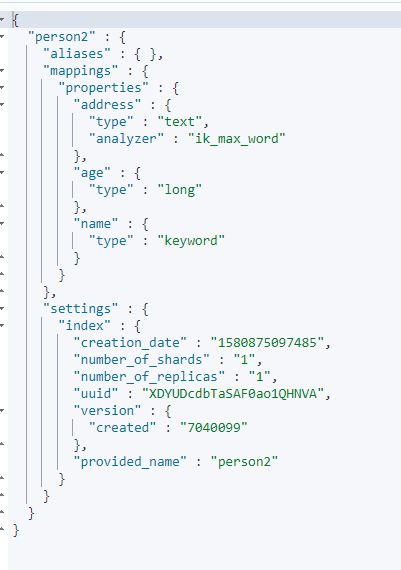
4.查看分词效果
GET _analyze
{
"analyzer": "ik_max_word",
"text": "北京海淀"
}
5.词条查询:term
查询person2中匹配到"北京"两字的词条
GET /person2/_search
{
"query": {
"term": {
"address": {
"value": "北京"
}
}
}
}
6.全文查询:match
全文查询会分析查询条件,先将查询条件进行分词,然后查询,求并集
GET /person2/_search
{
"query": {
"match": {
"address":"北京昌平"
}
}
}
4 ElasticSearch核心概念
索引(index)
ElasticSearch存储数据的地方,可以理解成关系型数据库中的数据库概念。
映射(mapping)
mapping定义了每个字段的类型、字段所使用的分词器等。相当于关系型数据库中的表结构。
文档(document)
Elasticsearch中的最小数据单元,常以json格式显示。一个document相当于关系型数据库中的一行数据。
倒排索引
一个倒排索引由文档中所有不重复词的列表构成,对于其中每个词,对应一个包含它的文档id列表。
类型(type)
一种type就像一类表。如用户表、角色表等。在Elasticsearch7.X默认type为_doc
ES 5.x中一个index可以有多种type。
ES 6.x中一个index只能有一种type。
ES 7.x以后,将逐步移除type这个概念,现在的操作已经不再使用,默认_doc
5 脚本操作ElasticSearch
(一)RESTful风格介绍
Restful就是一个资源定位及资源操作的风格。不是标准也不是协议,只是一种风格。基于这个风格设计的软件可以更简洁,更有层次,可以降低开发的复杂性,提高系统的可伸缩性。
特点:
1.基于http协议
2.使用XML格式定义或JSON格式定义
3.每一个URI代表1种资源。
4.客户端使用GET、POST、PUT、DELETE 4个表示操作方式的动词对服务端资源进行操作:
GET:用来获取资源
POST:用来新建资源(也可以用于更新资源)
PUT:用来更新资源
DELETE:用来删除资源
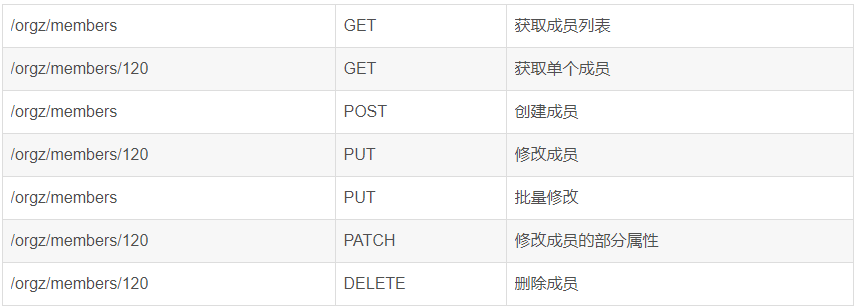
(二)操作索引
1 创建索引(PUT)
http://ip:端口/索引名称
案例:
http://192.168.126.20:9200/index_01
2 查询索引(GET)
GET http://ip:端口/索引名称 # 查询单个索引信息
GET http://ip:端口/索引名称1,索引名称2... # 查询多个索引信息
GET http://ip:端口/_all # 查询所有索引信息
3 删除索引(DELETE)
DELETE http://ip:端口/索引名称
4 关闭、打开索引(了解)
POST http://ip:端口/索引名称/_close
POST http://ip:端口/索引名称/_open
(三)ElasticSearch 数据类型
1 简单数据类型
| 数据类型 | 备注 |
|---|---|
| 字符串 | text :会分词,不支持聚合 相当于mysql 中的sum(求和) |
| keyword:不会分词,将全部内容作为一个词条,支持聚合 | |
| 数值 | byte, short, integer, long, float, double |
| 布尔 | boolean |
| 范围类型 | integer_range, float_range, long_range, double_range, date_range |
| 日期 | date |
2 复杂数据类型
| 数据类型 | 备注 |
|---|---|
| 数组: [ ] | nested (for arrays of JSON objects 数组类型的JSON对象) |
| 对象:{ } | object(for single JSON objects 单个JSON对象) |
(四)操作映射
1 查询映射
GET /索引的名称/_mapping
2 创建映射
2.1 创建索引后添加映射
#创建一个person 索引
PUT person
#查询person 索引的mapping 是空
GET /person/_mapping
#给person 添加索引
PUT /person/_mapping
{
"properties":{
"name":{
"type":"text"
},
"age":{
"type":"integer"
}
}
}
2.2 创建索引并添加映射
#创建索引并且添加映射
PUT person2
{
"mappings": {
"properties": {
"name":{
"type":"text"
},
"age":{
"type": "integer"
}
}
}
}
#查询映射
GET person2/_mapping
添加字段
#给创建好的索引添加字段
PUT /person2/_mapping
{
"properties":{
"address":{
"type":"text"
}
}
}
总结:在实际当中 ,我们很少操作映射,一般都是使用API方式操作文档,所以以上的操作只需要能看懂就可以。
(五) 操作文档
1 查询文档
#根据id查询具体的文档
语法: GET /索引的名称/_doc/索引的id
案例: GET /person1/_doc/1
#查询所有的文档
语法:GET /索引名称/_search
案例:GET /person1/_search
2 添加文档,指定id
#语法:POST /索引的名称/文档的类型/文档的id
POST /person2/_doc/1
{
"name":"张三",
"age":18,
"address":"北京"
}
#查询文档
GET /person1/_doc/1
添加文档,不指定id
#添加文档,不指定id
POST /person1/_doc/
{
"name":"张三",
"age":18,
"address":"北京"
}
#查询所有文档
GET /person1/_search
3 删除文档
#删除指定id文档
DELETE /person1/_doc/1
7 ElasticSearch JavaAPI
(一)SpringBoot整合ElasticSearch环境搭建
1 搭建SpringBoot工程
2 引入ElasticSearch相关坐标
<!--引入es的坐标-->
<dependency>
<groupId>org.elasticsearch.client</groupId>
<artifactId>elasticsearch-rest-high-level-client</artifactId>
<version>7.4.0</version>
</dependency>
<dependency>
<groupId>org.elasticsearch.client</groupId>
<artifactId>elasticsearch-rest-client</artifactId>
<version>7.4.0</version>
</dependency>
<dependency>
<groupId>org.elasticsearch</groupId>
<artifactId>elasticsearch</artifactId>
<version>7.4.0</version>
</dependency>
3 编写核心配置类
编写核心配置文件:
elasticsearch:
hostname: 192.168.126.20
port: 9200
编写核心配置类
@Configuration
@ConfigurationProperties(prefix="elasticsearch")
public class ElasticSearchConfig {
private String host;
private int port;
@Bean
public RestHighLevelClient client(){
return new RestHighLevelClient(RestClient.builder(
new HttpHost(host,port,"http")
));
}
public String getHost() {
return host;
}
public void setHost(String host) {
this.host = host;
}
public int getPort() {
return port;
}
public void setPort(int port) {
this.port = port;
}
}
4 测试客户端对象
注意:使用@Autowired注入RestHighLevelClient 如果报红线,则是因为配置类所在的包和测试类所在的包,包名不一致造成的
@SpringBootTest
class SpringElasticsearchApplicationTests {
@Autowired
private RestHighLevelClient restHighLevelClient;
@Test
void contextLoads() {
System.out.println(restHighLevelClient);
}
}
(二)操作ElasticSearch
1 添加索引
/**
* 添加索引:
* @throws Exception
*/
@Test
public void addIndex() throws Exception{
//1:使用restHighLevelClient获取操作索引的对象
IndicesClient indices = restHighLevelClient.indices();
//2: 具体操作索引,并且获得返回值
//2.1 创建索引对象,设置索引的名称
CreateIndexRequest createIndexRequest = new CreateIndexRequest("offcn");
//2.2 创建索引,获得返回值
CreateIndexResponse createIndexResponse = indices.create(createIndexRequest, RequestOptions.DEFAULT);
//3:根据返回值判断返回结果
System.out.println(createIndexResponse.isAcknowledged());
}
2 添加索引,并添加映射
/**
* 创建索引并且添加映射
* @throws IOException
*/
@Test
public void addIndexAndMapping() throws IOException {
//1.使用client获取操作索引的对象
IndicesClient indicesClient = restHighLevelClient.indices();
//2.具体操作,获取返回值
CreateIndexRequest createRequest = new CreateIndexRequest("offcn");
//2.1 设置mappings
String mapping = "{\n" +
" \"properties\" : {\n" +
" \"address\" : {\n" +
" \"type\" : \"text\",\n" +
" \"analyzer\" : \"ik_max_word\"\n" +
" },\n" +
" \"age\" : {\n" +
" \"type\" : \"long\"\n" +
" },\n" +
" \"name\" : {\n" +
" \"type\" : \"keyword\"\n" +
" }\n" +
" }\n" +
" }";
createRequest.mapping(mapping, XContentType.JSON);
//2.2执行创建,返回对象
CreateIndexResponse response = indicesClient.create(createRequest, RequestOptions.DEFAULT);
//3.根据返回值判断结果
System.out.println(response.isAcknowledged());
}
3 查询、删除、判断索引
3.1 查询索引
/**
* 查询索引
*/
@Test
public void queryIndex() throws IOException {
//1:使用client获取操作索引的对象
IndicesClient indices = restHighLevelClient.indices();
//2:获得对象,执行具体的操作
//2.1 创建获取索引的请求对象,设置索引名称
GetIndexRequest getReqeust = new GetIndexRequest("offcn");
//2.2 执行查询,获得返回值
GetIndexResponse response = indices.get(getReqeust, RequestOptions.DEFAULT);
//3:获取结果,遍历
Map<String, MappingMetaData> mappings = response.getMappings();
for (String key : mappings.keySet()) {
System.out.println(key + ":" + mappings.get(key).getSourceAsMap());
}
}
3.2 删除索引
/**
* 删除索引
*/
@Test
public void deleteIndex() throws IOException {
IndicesClient indices = restHighLevelClient.indices();
DeleteIndexRequest deleteRequest = new DeleteIndexRequest("offcn");
AcknowledgedResponse response = indices.delete(deleteRequest, RequestOptions.DEFAULT);
System.out.println(response.isAcknowledged());
}
3.3 索引是否存在
/**
* 判断索引是否存在
*/
@Test
public void existIndex() throws IOException {
IndicesClient indices = restHighLevelClient.indices();
GetIndexRequest getRequest = new GetIndexRequest("person");
boolean exists = indices.exists(getRequest, RequestOptions.DEFAULT);
System.out.println(exists);
}
4 操作文档
4.1 添加文档
添加文档,使用map作为数据
/**
* 添加文档,使用map作为数据
*/
@Test
public void addDoc() throws IOException {
//数据对象,map
Map data = new HashMap();
data.put("address", "北京昌平");
data.put("name", "马同志");
data.put("age", 20);
//1:获取操作文档的对象
IndexRequest request = new IndexRequest("offcn").id("1").source(data);
//2:添加数据,获取结果
IndexResponse response = restHighLevelClient.index(request, RequestOptions.DEFAULT);
//3:打印响应结果
System.out.println(response.getId());
}
添加文档,使用对象作为数据
/**
* 添加文档,使用对象作为数据
*/
@Test
public void addDoc2() throws IOException {
//数据对象,javaObject
Person p = new Person();
p.setId("2");
p.setName("小胖2222");
p.setAge(30);
p.setAddress("陕西西安");
//将对象转为json
String data = JSON.toJSONString(p);
//1:获取操作文档的对象
IndexRequest request = new IndexRequest("offcn").id(p.getId()).source(data, XContentType.JSON);
//2:添加数据,获取结果
IndexResponse response = restHighLevelClient.index(request, RequestOptions.DEFAULT);
//3:打印响应结果
System.out.println(response.getId());
}
4.2 修改文档:添加文档时,如果id存在则修改,id不存在则添加
/**
* 修改文档:添加文档时,如果id存在则修改,id不存在则添加
*/
@Test
public void updateDoc() throws IOException {
//数据对象,map
Map data = new HashMap();
data.put("address", "北京昌平");
data.put("name", "朱同志");
data.put("age", 20);
//1:获取操作文档的对象
IndexRequest request = new IndexRequest("offcn").id("1").source(data);
//2:添加数据,获取结果
IndexResponse response = restHighLevelClient.index(request, RequestOptions.DEFAULT);
//3:打印响应结果
System.out.println(response.getId());
}
4.3 根据id查询文档
/**
* 根据id查询文档
*/
@Test
public void findDocById() throws IOException {
GetRequest getReqeust = new GetRequest("offcn", "1");
//getReqeust.id("1");
GetResponse response = restHighLevelClient.get(getReqeust, RequestOptions.DEFAULT);
//获取数据对应的json
System.out.println(response.getSourceAsString());
}
4.4 根据id删除文档
/**
* 根据id删除文档
*/
@Test
public void delDoc() throws IOException {
DeleteRequest deleteRequest = new DeleteRequest("offcn", "1");
DeleteResponse response = restHighLevelClient.delete(deleteRequest, RequestOptions.DEFAULT);
System.out.println(response.getId());
}
(三)ElasticSearch的批量操作
1 bulk 批量操作脚本实现
需求:同时完成删除,更新,添加操作
POST _bulk
{"delete":{"_index":"person1","_id":"4"}}
{"create":{"_index":"person1","_id":"5"}}
{"name":"八号","age":18,"address":"北京"}
{"update":{"_index":"person1","_id":"2"}}
{"doc":{"name":"2号"}}
查询运行结果~
2 bulk批量操作JavaAPI 实现
/**
* Bulk 批量操作
*/
@Test
public void test2() throws IOException {
//创建bulkrequest对象,整合所有操作
BulkRequest bulkRequest =new BulkRequest();
/*
# 1. 删除5号记录
# 2. 添加6号记录
# 3. 修改3号记录 名称为 “三号”
*/
//添加对应操作
//1. 删除5号记录
DeleteRequest deleteRequest=new DeleteRequest("person1","5");
bulkRequest.add(deleteRequest);
//2. 添加6号记录
Map<String, Object> map=new HashMap<>();
map.put("name","六号");
IndexRequest indexRequest=new IndexRequest("person1").id("6").source(map);
bulkRequest.add(indexRequest);
//3. 修改3号记录 名称为 “三号”
Map<String, Object> mapUpdate=new HashMap<>();
mapUpdate.put("name","三号");
UpdateRequest updateRequest=new UpdateRequest("person1","3").doc(mapUpdate);
bulkRequest.add(updateRequest);
//执行批量操作
BulkResponse response = client.bulk(bulkRequest, RequestOptions.DEFAULT);
System.out.println(response.status());
}
3 导入数据分析&创建索引
需求: 将数据库中Good表的数据导入到ElasticSearch当中
实现步骤:
分析goods表结构
创建goods索引
查询Goods表数据
批量添加到ElasticSearch中
PUT goods
{
"mappings": {
"properties": {
"title": {
"type": "text",
"analyzer": "ik_smart"
},
"price": {
"type": "double"
},
"createTime": {
"type": "date"
},
"categoryName": {
"type": "keyword"
},
"brandName": {
"type": "keyword"
},
"spec": {
"type": "object"
},
"saleNum": {
"type": "integer"
},
"stock": {
"type": "integer"
}
}
}
}
title:商品标题
price:商品价格
createTime:创建时间
categoryName:分类名称。如:家电,手机
brandName:品牌名称。如:华为,小米
spec: 商品规格。如: spec:{“屏幕尺寸”,“5寸”,“内存大小”,“128G”}
saleNum:销量
stock:库存量
插入一条测试数据
POST goods/_doc/1
{
"title":"小米手机",
"price":1000,
"createTime":"2021-12-01",
"categoryName":"手机",
"brandName":"小米",
"saleNum":3000,
"stock":10000,
"spec":{
"网络制式":"移动4G",
"屏幕尺寸":"4.5"
}
}
4 导入数据代码实现
/**
* 从Mysql 批量导入 elasticSearch
*/
@Test
public void test3() throws IOException {
//1.查询所有数据,mysql
List<Goods> goodsList = goodsMapper.findAll();
//2.bulk导入
BulkRequest bulkRequest=new BulkRequest();
//2.1 循环goodsList,创建IndexRequest添加数据
for (Goods goods : goodsList) {
//2.2 设置spec规格信息 Map的数据 specStr:{}
String specStr = goods.getSpecStr();
//将json格式字符串转为Map集合
Map map = JSON.parseObject(specStr, Map.class);
//设置spec map
goods.setSpec(map);
//将goods对象转换为json字符串
String data = JSON.toJSONString(goods);
IndexRequest indexRequest=new IndexRequest("goods").source(data,XContentType.JSON);
bulkRequest.add(indexRequest);
}
BulkResponse response = client.bulk(bulkRequest, RequestOptions.DEFAULT);
System.out.println(response.status());
}
(四)ElasticSearch高级查询
1 matchAll脚本实现
# 默认情况下,es一次展示10条数据,通过from和size来控制分页
# 查询结果详解
GET goods/_search
{
"query": {
"match_all": {}
},
"from": 0,
"size": 100
}
GET goods
2 matchAll-JavaAPI
/**
* 查询所有
* 1. matchAll
* 2. 将查询结果封装为Goods对象,装载到List中
* 3. 分页。默认显示10条
*/
@Test
public void matchAll() throws IOException {
//2. 构建查询请求对象,指定查询的索引名称
SearchRequest searchRequest=new SearchRequest("goods");
//4. 创建查询条件构建器SearchSourceBuilder
SearchSourceBuilder sourceBuilder=new SearchSourceBuilder();
//6. 查询条件
QueryBuilder queryBuilder= QueryBuilders.matchAllQuery();
//5. 指定查询条件
sourceBuilder.query(queryBuilder);
//3. 添加查询条件构建器 SearchSourceBuilder
searchRequest.source(sourceBuilder);
// 8 . 添加分页信息 不设置 默认10条
// sourceBuilder.from(0);
// sourceBuilder.size(100);
//1. 查询,获取查询结果
SearchResponse searchResponse = client.search(searchRequest, RequestOptions.DEFAULT);
//7. 获取命中对象 SearchHits
SearchHits hits = searchResponse.getHits();
//7.1 获取总记录数
Long total= hits.getTotalHits().value;
System.out.println("总数:"+total);
//7.2 获取Hits数据 数组
SearchHit[] hits1 = hits.getHits();
//获取json字符串格式的数据
List<Goods> goodsList = new ArrayList<>();
for (SearchHit searchHit : hits1) {
String sourceAsString = searchHit.getSourceAsString();
//转为java对象
Goods goods = JSON.parseObject(sourceAsString, Goods.class);
goodsList.add(goods);
}
for (Goods goods : goodsList) {
System.out.println(goods);
}
}
3 termQuery 词条查询
term查询和字段类型有关系,首先回顾一下ElasticSearch两个数据类型
ElasticSearch两个数据类型:
text:会分词,不支持聚合
keyword:不会分词,将全部内容作为一个词条,支持聚合
脚本实现:
#term查询: 查询title当中包含 华为
GET /goods/_search
{
"query": {
"term": {
"title": {
"value": "华为"
}
}
}
}
javaAPI代码实现:
/**
* termQuery:词条查询
*/
@Test
public void testTermQuery() throws IOException {
SearchRequest searchRequest = new SearchRequest("goods");
SearchSourceBuilder sourceBulider = new SearchSourceBuilder();
QueryBuilder query = QueryBuilders.termQuery("title","华为");//term词条查询
sourceBulider.query(query);
searchRequest.source(sourceBulider);
SearchResponse searchResponse = client.search(searchRequest, RequestOptions.DEFAULT);
SearchHits searchHits = searchResponse.getHits();
//获取记录数
long value = searchHits.getTotalHits().value;
System.out.println("总记录数:"+value);
List<Goods> goodsList = new ArrayList<>();
SearchHit[] hits = searchHits.getHits();
for (SearchHit hit : hits) {
String sourceAsString = hit.getSourceAsString();
//转为java
Goods goods = JSON.parseObject(sourceAsString, Goods.class);
goodsList.add(goods);
}
for (Goods goods : goodsList) {
System.out.println(goods);
}
}
4 matchQuery
match查询,会对查询条件分词,然后将分词后的查询条件和词条进行等值匹配,默认取并集(OR)
# match查询
GET goods/_search
{
"query": {
"match": {
"title": "华为手机"
}
},
"size": 500
}
match 的默认搜索(or 并集)
例如:华为手机,会分词为 “华为”,“手机” 只要出现其中一个词条都会搜索到
match的 and(交集) 搜索
例如:例如:华为手机,会分词为 “华为”,“手机” 但要求“华为”,和“手机”同时出现在词条
总结:
term query会去倒排索引中寻找确切的term,它并不知道分词器的存在。这种查询适合keyword 、numeric、date
match query知道分词器的存在。并且理解是如何被分词的
5 模糊查询脚本实现
通配符使用,?代表任意单个字符,*代表0个或者是多个字符
案例:
"*华*" 包含华字的
"华*" 华字后边多个字符
"华?" 华字后边单个字符
"*华"或"?华" 会引发全表(全索引)扫描 注意效率问题
# wildcard 查询。查询条件分词,模糊查询
GET goods/_search
{
"query": {
"wildcard": {
"title": {
"value": "华*"
}
}
}
}
6 模糊查询javaAPI
//模糊查询
WildcardQueryBuilder query = QueryBuilders.wildcardQuery("title", "华*");//华后多个字符
7 范围查询脚本实现
# 范围查询
GET goods/_search
{
"query": {
"range": {
"price": {
"gte": 2000,
"lte": 3000
}
}
},
"sort": [
{
"price": {
"order": "desc"
}
}
]
}
8 范围查询API实现
//范围查询 以price 价格为条件
RangeQueryBuilder query = QueryBuilders.rangeQuery("price");
//指定下限
query.gte(2000);
//指定上限
query.lte(3000);
sourceBuilder.query(query);
//排序 价格 降序排列
sourceBuilder.sort("price",SortOrder.DESC);
9 queryString 查询
queryString 多条件查询
会对查询条件进行分词。
然后将分词后的查询条件和词条进行等值匹配
默认取并集(OR)
可以指定多个查询字段
query_string:识别query中的连接符(or 、and)
# queryString
GET goods/_search
{
"query": {
"query_string": {
"fields": ["title","categoryName","brandName"],
"query": "华为 AND 手机"
}
}
}
simple_query_string:不识别query中的连接符(or 、and),查询时会将 “华为”、“and”、“手机”分别进行查询
GET goods/_search
{
"query": {
"simple_query_string": {
"fields": ["title","categoryName","brandName"],
"query": "华为 AND 手机"
}
}
}
10 queryString javaAPI代码实现:
QueryStringQueryBuilder query = QueryBuilders.queryStringQuery("华为手机").field("title").field("categoryName")
.field("brandName").defaultOperator(Operator.AND);
11 聚合查询脚本实现
指标聚合:相当于MySQL的聚合函数。max、min、avg、sum等
桶聚合:相当于MySQL的 group by 操作。不要对text类型的数据进行分组,会失败
# 聚合查询
# 指标聚合 聚合函数
GET goods/_search
{
"query": {
"match": {
"title": "手机"
}
},
"aggs": {
"max_price": {
"max": {
"field": "price"
}
}
}
}
# 桶聚合 分组
GET goods/_search
{
"query": {
"match": {
"title": "手机"
}
},
"aggs": {
"goods_brands": {
"terms": {
"field": "brandName",
"size": 100
}
}
}
}
12 聚合查询JavaAPI
聚合查询:桶聚合,分组查询
-
查询title包含手机的数据
-
查询品牌列表
/** * 聚合查询:桶聚合,分组查询 * 1. 查询title包含手机的数据 * 2. 查询品牌列表 */ @Test public void testAggQuery() throws IOException { SearchRequest searchRequest=new SearchRequest("goods"); SearchSourceBuilder sourceBuilder=new SearchSourceBuilder(); //1. 查询title包含手机的数据 MatchQueryBuilder queryBuilder = QueryBuilders.matchQuery("title", "手机"); sourceBuilder.query(queryBuilder); //2. 查询品牌列表 只展示前100条 AggregationBuilder aggregation=AggregationBuilders.terms("goods_brands").field("brandName").size(100); sourceBuilder.aggregation(aggregation); searchRequest.source(sourceBuilder); SearchResponse searchResponse = client.search(searchRequest, RequestOptions.DEFAULT); //7. 获取命中对象 SearchHits SearchHits hits = searchResponse.getHits(); //7.1 获取总记录数 Long total= hits.getTotalHits().value; System.out.println("总数:"+total); // aggregations 对象 Aggregations aggregations = searchResponse.getAggregations(); //将aggregations 转化为map Map<String, Aggregation> aggregationMap = aggregations.asMap(); //通过key获取goods_brands 对象 使用Aggregation的子类接收 buckets属性在Terms接口中体现 // Aggregation goods_brands1 = aggregationMap.get("goods_brands"); Terms goods_brands =(Terms) aggregationMap.get("goods_brands"); //获取buckets 数组集合 List<? extends Terms.Bucket> buckets = goods_brands.getBuckets(); Map<String,Object>map=new HashMap<>(); //遍历buckets key 属性名,doc_count 统计聚合数 for (Terms.Bucket bucket : buckets) { System.out.println(bucket.getKey()); map.put(bucket.getKeyAsString(),bucket.getDocCount()); } System.out.println(map); }